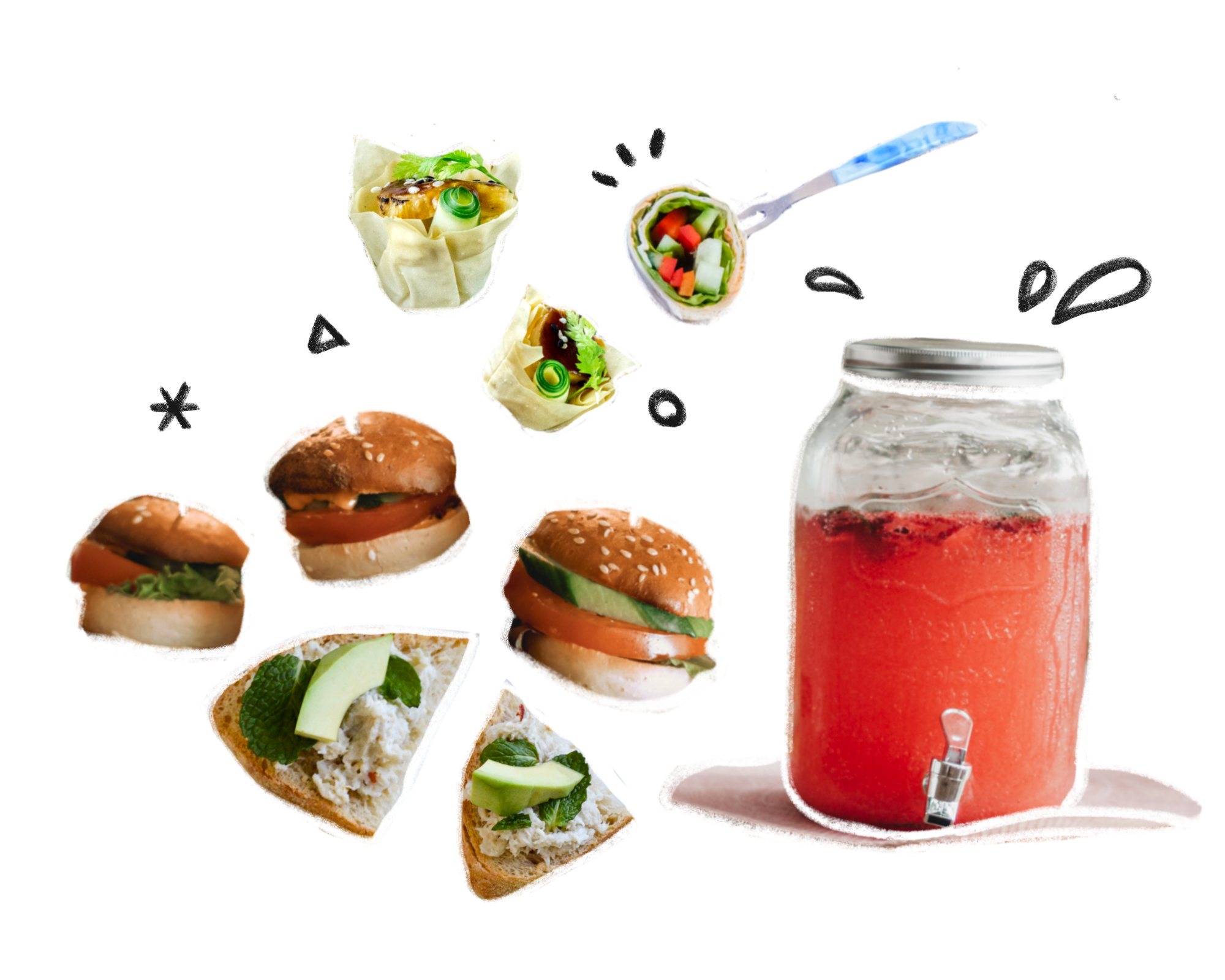
Let’s Redefine Birthday Parties.
Make mindful, meaningful, sustainable decisions for your kids and the planet.
WHY SAY YES TO LESS?
Birthday parties can be stressful for parents, their wallets and the planet. While those joyful moments will last forever in our memories, where will all that waste from the parties go? The average person generates over 4 pounds of trash every day and about 1.5 tons of solid waste per year. Multiply that by 7 billion. Now add to that all the waste in every party in every corner of every town, all across the globe, every single day. Whew! Landfills and natural environments are the final destinations for more than three-quarters of nondegradable plastic trash, which can take anywhere from 20 to 500 years to decompose, and some will never break down.
Directed and Written by Soo Min Seol | Director of Photography Cristie Kwon | Starring: Noah Moon, Minji Kim | Voice Actor Josh Ahn | Edited by Cristie Kwon and Soo Min Seol | Illustrated by Soo Min Seol | Music: “Bluest Blue” by Music Box and “Jee Louie” by Condor
Sustainable living is all about finding responsible ways to protect the earth for future generations. As adults, we should make mindful decisions in our daily lives based on environmental impact for a more sustainable and brighter future and so our kids can recognize their own role in keeping Earth beautiful.
Say Yes To Less embraces the idea that sustainable birthday parties can change a world often focused on "more” and make celebrations more meaningful, more mindful and more sustainable for your kids and the planet!
MAKE A GREEN CHOICE
Paperless Invitation
Ever wonder where all those beautiful invitations end up? Many of them are headed to the trash! These cards are hard to recycle because they are mostly made of mixed materials, which makes them destined for the landfill, creating even more greenhouse gas emissions. Not only that, mailing a single card — including shipping and paper production — emits about 140 grams of carbon dioxide and equivalent gasses. Let’s think outside the envelope!
-
Sending invitations digitally not only reduces the amount of rubbish that will go into landfills and the carbon footprint but also saves your wallet and party budget.
Here are a list of websites where you can make digital invitations to eliminate the need for paper altogether: Evite, Greenvelope, Punchbowl, and Paperless Post
-
Can’t resist physical invitations? Post-consumer paper offers a reliable, eco-friendly alternative to bleached recycled paper. Post-consumer paper is made from 100% post-consumer waste which is different from regular recycled paper and produced entirely from paper out of your own recycling bin. Here are some lists of brands that create physical invitations in a sustainable way:
• Paperculture uses 100% post-consumer recycled paper which means no trees are cut down in the process and each order plants a tree.
• Botanical PaperWorks creates biodegradable seed paper that can grow into wildflowers, herbs or vegetables.
• Artifact Uprising is one of the first photo book companies to use Mohawk Options Paper, which contains 100% post-consumer fiber. It intentionally selects paper composed of recycled fibers for its products.
• LittleGreenPaperShop produces 100% plastic free and biodegradable papers and you can grow seed paper with their paper at home! They send the order in a box picked up from a local store or one from an item they had delivered to themselves to reduce waste from packaging.
-
Think out of the box! You can create a movie trailer for your kid’s party invitation. All the tools you need are available on social media apps such as Instagram and Tik Tok. Simply record your narration, including the date, time and theme of your party. You can also mention any additional notes to make the party more sustainable such as bringing your own choice of drink or snack, and bringing mindful gifts.
In addition, you can also create them through video invitation maker platforms such as Canva, FlexClip or InVideo.
Wasteless Food & Drink
America wastes roughly 30-40% of its food, much of which is perfectly edible and nutritious. The main reason we end up with too much food at parties is that we overestimate our guests’ appetites for fear of under-catering. Reducing food waste is one of the easiest and most powerful decisions you can make to save money and lower your climate change footprint.
-
Hosting a potluck-style party where your guests bring what they like to eat. Make sure to ask them to bring these food items in reusable casserole dishes and items in glass or ceramic instead of plastic trays.
-
Going for finger foods where people can easily pop in their mouths over a napkin like mac and cheese bites, veggie and fruit kabobs, mini-toasts, muffins, bars etc. It not only can save water used in cleaning dishes but also skip using plates or utensils, saving on waste.
-
Buying produce from local or farmer’s markets creates less packaging, generally less expensive and cuts down on the transportation factor. Not only that, food tastes better when it is local because it is fresh, not prepackaged and loaded with chemicals. You’re not only helping the environment, but you’re adding a healthy flair for your party guests.
-
Americans throw away more than 70 million plastic water and soda bottles every single day and we don’t want to create more waste! Instead of bottled water, or soda, consider trying a drink dispenser or making large containers of iced tea, lemonade, juice, or even water with fruit in it. If you are in need of buying individual packaged drinks, aluminum cans are better than plastic bottles when it comes to serving sodas.
-
Making a short questionnaire or survey asking ahead of time what your guests can or can’t eat could prevent ending up with leftover food in the bin. You can also let them bring their drink of choice so they can bring home what they don’t consume. If you have a large number of guests, The Guest-imator can be a helpful tool to estimate how much food you need to buy and serve.
Plasticless Tableware
The biggest offender at parties is usually single-use plastics, which break down into microplastics that absorb toxins and contaminate our environment. Because plastic materials include chemical additives, they not only harm public health but also pollute our water sources!
-
Try to use everyday dishes such as enamel, ceramic, glasses, stainless steel plates and silverware you can wash and reuse every time. Using “real” plates, cups, and silverware are better options than using disposable items because they will be a waste of resources and end up in a landfill.
-
If for whatever reason you can only go disposable, opt for compostable options like waxed or untreated paper, bamboo, clay-coated or sugarcane plates, cups, cutlery and napkins. This means no glitter, shine, or fancy textures or designs on them. If you're unsure, keep an eye out for words like "certified compostable" or "biodegradable" not so-called “compostable plastic.”
At the very least, make sure to avoid Polystyrene, well-known as Styrofoam. Because they are not readily recyclable and these small pieces easily scatter, the materials end up in landfills, waste-to-energy facilities and contamintate the environment.
-
Every day Americans use enough plastic straws to circle the Earth 2.5 times! Plastic straws are used for convenience and an example of unnecessary single use plastic. Plastic straws are not recyclable because they are small and either fall through screeners and end up being sent to the landfill, or mix in with other materials in recycling facilities contaminating the loads.
If you are very pro-straw or need straws due to physical issues, choose compostable straws, naturally degradable or edible types of straws such as paper, bamboo, wheat straws, cane, pasta straws. Stainless steel, glass, and silicone straws that can be used over and over are other good options for reuse purposes.
-
Borrowing from friends or neighbors, browsing thrift stores, or renting from rental companies could be good options! Check out Party Kit Network where you can rent out a box of reusable tableware for celebrations and then return it to be used again.
Timeless Gifts
To most kids, opening gifts is the peak of the birthday experience. Because most toys are made entirely out of plastic or a mixture of different materials, they are generally considered waste and end up in landfills, incinerators and even the ocean. Inevitably, our children's interest in these toys disappears as the months and years go by. As a parent, you might be left wondering what to do with the toys they no longer use. Although giving gifts is a good way of showing appreciation and love, let’s find some alternatives for sustainable gifting.
-
When finding a gift for a child, we tend to go shopping for something brand spanking new. Why don’t we start shifting our consumerist mindset to a more eco-conscious lifestyle? Gifting second-hand toys or items is one of the most sustainable options because it’s environmental- and budget-friendly. There are even online websites dedicated to selling gently used second-hand toys such as Toycycle and GoodBuyGear.
You can also make birthday gift time as swap toy time by encouraging each kid to bring a used toy or something they want to upcycle to the party such as unwanted clothes, games, toys and books and they will swap it for someone else's. This would also teach your kids how sharing is caring for each other.
-
Electronic waste is also a big issue in the landfills in America as many people are not aware of how to dispose of them properly. Since most batteries contain toxic chemicals, batteries ending up in a landfill can cause environmental issues such as leaking out and contaminating groundwater and damaging fragile ecosystems.
If you have to keep gift-giving traditions with toys for your kids, try to select toys that do not require the use of batteries. If you do want to choose toys that require batteries, invest in getting rechargeable batteries that last longer and are a more eco-conscious purchase for regular batteries.
Toys made with wood, organic cotton, non-toxic and recycled materials are safer gift options than plastic toys. Wooden toys are recommended since they are long-lasting and more durable, causing less waste than plastic toys and can get passed down through the generations.
-
Meaningful gifts don't have to be tangible or expensive. Experience gifts are by far the most eco-friendly option, including tickets or annual pass or membership, to the zoo, aquarium, amusement park or water park, music lessons, or tickets to a sporting event. Not only do experience gifts eliminate waste, but they are also fun, educational, and provide opportunities for bonding, creating cherished memories between parents and kids.
-
It is totally acceptable to host a “no-gift” birthday party if you politely request or put “No gifts, please!” in the invitation. Yet, no-gift parties may feel awkward and uncomfortable to some people because it’s not the norm.
If you would like to find alternatives to no-gift party, here are meaningful gifts ideas that you and your guests can do together for your kid’s special day, by providing options what they would like to contribute:
• Chipping in together to purchase something your kid really wants.
• Ask each guest to bring a non-perishable food item that you will later donate to the local food bank.
• Ask guests to contribute food your child likes to the party
• Request donations to the charitable organizations your kids want to support or at least handmade cards.
-
Gift wrapping gives the first impression to the celebrant before opening the gift. Yet, this will be torn into shreds and tossed away in less than 60 seconds. Americans spent a total of $12.7 billion on gift wrap, including wrapping paper, tissue paper and gift bags, in 2017. Similar to plates and cups, you want to avoid gift wrapping with glitter, shine, etc. as they are lined with plastic and not recyclable. There are many eco-friendly choices you can make for gift wrapping when you are looking around. For example, instead of purchasing string ribbons, use real flower or plant paper ribbon or cut your unwanted or old clothes. If you would like to wrap your gift, here are some earth- and budget-friendly alternatives to reduce waste while letting your creativity out with your kids and doing DIY projects!
• Kids’ drawings or paintings
• Brown kraft paper
• Burlap
• Newspaper
• Reused cardboard box
• Fabric wrapping Cloth
• Old travel map
• The comics
• Grocery shopping bag
• Recycled paper stamped with fun patterns
Shopless Decorations
Decorations create ambiance and often carry the theme of the party, making everyone feel special. But festive trimmings such as balloons, shiny confetti and glitter are huge environmental threats, polluting landscapes and oceans. Instead of buying new decorations every time, consider a green alternative: Look around the house and recycle something. With a few simple DIY ideas, you can transform your child’s birthday party into a creative and sustainable one!
-
Disposable balloons, whether latex or metallic mylar, take hundreds of years to degrade. It is ranked as the third deadliest ocean trash because balloons can easily be mistaken as foliage and food to wildlife, particularly birds and marine animals, causing intestinal blockage and death. Here are some ideas that you can replace with balloons at the party:
• Bubble machines
-
Confetti is small pieces of plastic that often ends up in oceans and waterways where it is consumed by wildlife. Glitter is also typically made from polyethylene, which is the same plastic found in plastic bags and a host of other products. Due to its small size, they also have the same negative impact as balloons and confetti, harming the environment. There are many creative and earth-friendly confetti and glitter alternatives that you can repurpose for other parties in the future.
• Fresh or dried leaves (eucalyptus, oak, hawthorn, etc.)
• Fresh or dried flower petals
• Dried lavender
-
As parents, you may be looking for fun things to do with kids. Particularly, working parents have a hard time balancing between work and time with their child. You can always go for DIY projects making future party decorations and games on weekends. It will help you have a quality time with your child and boost their creativity! Plus, it would be more meaningful to explain to your kids why you and your child are making decorations instead of buying it from the stores.
Here are some other alternative decoration DIY ideas that will make your kid’s birthday party more sustainable:
• Hat
• Crown
• Garland
• Banner
-
If you don’t have time to craft with your kids, you can always find affordable or used items on Craigslist, a Buy Nothing Project, Facebook Marketplace, Ebay used section or buy disposable items. Online shops for eco-conscious, sustainable gatherings such as Eco Party Time also offer a variety of sustainable party decorations, supplies, tableware and gifts for holidays and everyday celebrations.
Tip! Avoid buying items that feature the “number” of each birthday which you can only use for a very limited time. Once you have a small box of reusable birthday decor (and maybe the spare #7 candle), you can offer it up to other parents who have birthdays coming up, encouraging them to reuse and buy less.
Stressless Cleanup
After the party, if you are like most of us, you might feel tempted to dump the remnants of the celebration straight into the garbage. But how you dispose of scraps and other waste is as important as planning the party itself. Most importantly, think ahead and make green decisions before throwing the party!
-
Set up clearly marked recycling, trash, and compost (if available) bins before the party. Let your guests know ahead what can go in each and encourage them to dispose of any trash properly. This will not only lighten your burden of cleaning up by yourself after the party but also encourage everyone to practice sustainable living.
-
If you have a compost at home or a local compost, drop off any food scraps there. They will make soil more fertile and efficient for future plants. Make sure to dispose of any compostable or biodegradable items properly as they won't decompose in landfill and rinse out recyclables before tossing in the recycling bin. It is important to check your local recycling guideline as some locations have specific recycling guidelines.
-
It’s always good to ask your guests ahead to bring their own containers for leftovers. If you've got leftovers, package them up in reusable containers or aluminum foil and give them to your guests instead of plastic wrap and ziplock. Although aluminum foil is commonly accepted for recycling, reduce the amount of it by swapping in reusable options such as glass or stainless steel food storage containers and beeswax food wraps.
You could also share leftovers with your neighbors. If there are any leftover ingredients and sealed food items, you can donate them to a local shelter or charity.
If you have DIY party decorations, just be sure to store them for future uses or give them to someone who can give them a second life.
SAY YES TO LESS
SAY YES TO LESS
Spread Yes to Less with Your Kids
Click the buttons on a mobile device to see the effect and try them with your kids!

Share Your Sustainability Story
We would love to hear your sustainability story or any tips you have for a kid’s sustainable birthday party.



















